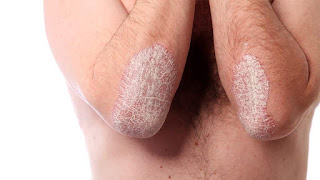WHAT IS PSORIASIS AND WHAT DOES IT LOOK LIKE???

Psoriasis is a chronic, non-contagious skin condition caused by the over-active immune system. On the skin, it appears as plaques of thickened, scaling skin or red scaly patches on the skin. The excessively rapid proliferation of skin cells gives an appearance of dry flakes on the skin. Psoriasis affects almost 2% of the world population and has a higher incidence rate in a temperate climate. It can appear at any age however in 75% of patients it occurs before the age of 40 years. It most commonly occurs on knees, elbows, and scalp but can also appear on torso, palms and soles of feet. Types and how it appears Chronic Plaque Disease: It is the most common variety-affecting majority of people. It appears as sharply defined, pinkish red (erythematous), plaques covered with silvery-white scales and symmetrically distributed. The degree of body surface area involvement can vary from limited to extensive. Guttate Psoriasis: Lesions are small discrete papules and plaques. M...


